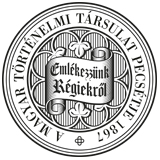Századok – 2012
KÖZLEMÉNYEK AZ 1711. ÉVI SZATMÁRI BÉKE TÖRTÉNETÉRŐL - Mészáros Kálmán: A szatmári béke aláírói és további sorsuk IV/887
A SZATMÁRI BÉKE ALÁÍRÓI ÉS TOVÁBBI SORSUK 911 szökött a kurucok közé. Előbb Doboka vármegye főkapitánya és hadbiztos, majd 1707-ben az ítélőtábla ülnöke és dobokai főispán lett.11 4 1721-től ismét táblai ülnök 1741 elején bekövetkezett haláláig. 1734 végén református részről guberniumi tanácsosságra is jelölték -eredménytelenül.11 5 THE SIGNATORIES OF THE PEACE OF SZATMÁR AND THEIR SUBSEQUENT DESTINIES by Kálmán Mészáros (Summary) Of the peace treaty of Szatmár two signed and sealed originals are known presently, both of which are preserved in the Staatsarhiu at Vienna. The two documents were signed, in the name of the political and military leadership which stayed in Hungary in the last months of the revolt, by 45 pro-Rákóczi leaders, partly in the order of ranks, partly according to various groups, such as the Hungarian and Transylvanian estates, the representatives of the towns of Máramaros, of Hungary, or the Transylvanian chief officers. An examination of the subsequent careers of these 45 leaders has yielded the following conclusions. Thanks to his services around establishing the peace treaty, Sándor Károlyi was not only able to elevate his family into a higher position within the aristocracy, but his political and military career also kept its momentum. His less able peers among the magnates, however, retired into private life. Several among the middling nobility and the military officers were offerred a possibility to pursue a career either in county administration or in the imperial army, although it can be shown that the Protestants sufferred disadvantages in the face of the Catholics. Four pro-Rákóczi colonels of non-noble origins (Mihály Nyúzó, Márton Kókai, Demeter Pikó and János Cseplész) were, in accordance with the second article of the peace treaty, ennobled by the new ruler, Charles III king of Hungary. Consequently, it can be stated that the subsequent careers of those who signed the peace treaty were mostly influenced, alongside the usual factors of patronage and confession, by their personal abilities. On the one hand, rebellious past was no obstacle to further career, and, on the other hand, no merits accumulated around the making of the peace agreement enabled anyone to rise beyond his own abilities. 114 A szakirodalomban szereplő azon adat, mely szerint már 1702-ben dobokai főispán lett volna, valószínűleg tévedés, egyéb archontológiai adatok legalábbis cáfolják ezt: Bánffy Farkas és Bánffy György viselték ugyanis e méltóságot, s Wass György volt a szabadságharc elején császári részről megbízott helyettes főispán. 115 Trócsányi Zs. : Habsburg-politika i. m. 400.
